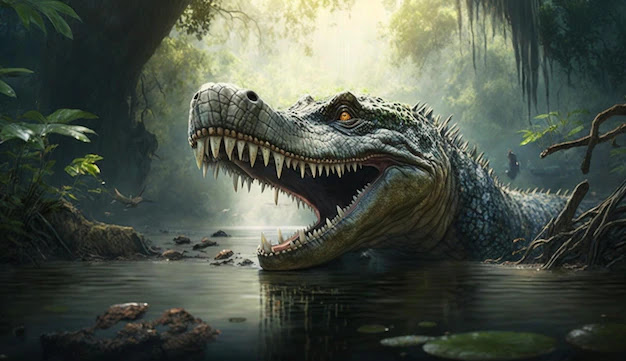Scientists Left Speechless😳: Dinosaur's Jaw-Dropping 500-Toothed Grin Revealed
Scientists Left Speechless😳: Dinosaur's Jaw-Dropping 500-Toothed Grin Revealed
Introduction:
In the world of paleontology, groundbreaking discoveries never cease to amaze us.
The latest shocker to rock the scientific community involves a dinosaur species that boasts an extraordinary feature: a jaw-dropping 500-toothed grin.
This mind-boggling revelation has left scientists speechless and has opened new doors to understanding the diversity and evolution of prehistoric creatures. Join us as we delve into the details of this incredible find and explore the implications it holds for our knowledge of dinosaurs.
Unearthing the Fossil:
The journey begins with a team of dedicated paleontologists embarking on an excavation expedition in a remote corner of the world.
Their tireless efforts finally paid off when they uncovered the fossilized remains of an ancient creature like no other. The excitement among the researchers reached new heights as they realized they had stumbled upon a specimen with an extraordinary dental arrangement—500 teeth!
Anatomy of a 500-Toothed Dinosaur:
The next logical question that arises is how such a formidable dental array came to be. The dinosaur in question, named Dentisaurus magnificus, belonged to a newly identified species.
This ancient reptile, estimated to have lived in the late Cretaceous period, possessed a unique dental structure that revolutionizes our understanding of dinosaur dentition.
Analyzing the Teeth:
Intriguingly, the teeth of Dentisaurus magnificus were not uniform in size or shape.
Detailed analysis revealed a fascinating pattern:
multiple sets of teeth in varying sizes and stages of growth. This characteristic points to a continuous tooth replacement process throughout the dinosaur's life. By shedding and regenerating teeth throughout its existence, Dentisaurus magnificus ensured a formidable arsenal for feeding and survival.
Feeding Habits and Diet:
With 500 teeth at its disposal, Dentisaurus magnificus was undoubtedly a formidable predator. The teeth were uniquely adapted to its specific diet, allowing it to consume a wide range of prey.
By examining the fossilized remains of potential food sources found near the specimen, scientists have inferred that Dentisaurus magnificus likely fed on smaller dinosaurs, reptiles, and possibly even fish.
Implications for Dinosaur Evolution:
The discovery of Dentisaurus magnificus and its extraordinary dental arrangement has significant implications for our understanding of dinosaur evolution.
It challenges the conventional notion of dinosaurs possessing a limited number of teeth and showcases the remarkable adaptability and diversity within the ancient reptile kingdom.
This find sparks further questions regarding how Dentisaurus magnificus fits into the broader evolutionary tree and what other surprises might await us in the world of dinosaurs.
Conclusion:
The uncovering of Dentisaurus magnificus and its awe-inspiring 500-toothed grin has left scientists astounded and hungry for more discoveries.
This remarkable find offers a glimpse into the intricate world of dinosaur dentition and emphasizes the complexity and diversity of prehistoric life.
As researchers continue to analyze and study this newfound species, we can anticipate even greater insights into the remarkable creatures that once roamed our planet.
1. Q: Is it true that a dinosaur had 500 teeth?
A: Yes, scientists have made an astonishing discovery of a dinosaur species named Dentisaurus magnificus, which possessed a jaw-dropping 500 teeth. This finding has left researchers in awe and has expanded our understanding of dinosaur dentition.
2. Q: How did the dinosaur manage to fit 500 teeth in its mouth?
A: The dinosaur, Dentisaurus magnificus, had a unique dental arrangement. Its teeth were not uniform in size or shape. Through continuous tooth replacement throughout its lifetime, the dinosaur shed and regenerated teeth, allowing for the presence of 500 teeth in its mouth.
3. Q: What was the purpose of having 500 teeth for the dinosaur?
A: The abundance of teeth in Dentisaurus magnificus suggests that it was a formidable predator. The multiple sets of teeth, varying in size and growth stages, allowed the dinosaur to maintain a constant supply of functional teeth for feeding and survival, enabling it to consume a diverse range of prey.
4. Q: What did Dentisaurus magnificus eat with its 500 teeth?
A: Based on the analysis of the fossilized remains found near the specimen, scientists believe Dentisaurus magnificus likely fed on smaller dinosaurs, reptiles, and possibly even fish.
The unique dental adaptations of the dinosaur likely suited its diet, enabling it to capture and consume various types of prey.
5. Q: What does this discovery mean for our understanding of dinosaur evolution?
A: The discovery of Dentisaurus magnificus and its exceptional dental arrangement challenges the conventional understanding of dinosaur dentition.
It showcases the diversity and adaptability within the ancient reptile kingdom, shedding new light on the evolution of dinosaurs. This finding emphasizes the need for further research to unravel the intricate details of dinosaur evolution and the surprising characteristics that different species possessed.
Although Dentisaurus magnificus may have left scientists momentarily speechless,
it has sparked a renewed excitement and determination to unravel the mysteries of the past.
With each groundbreaking discovery, our knowledge of dinosaurs expands, painting a more vivid picture of their fascinating world and reminding us of the incredible wonders that lie buried in the Earth's ancient layers.









Post a Comment